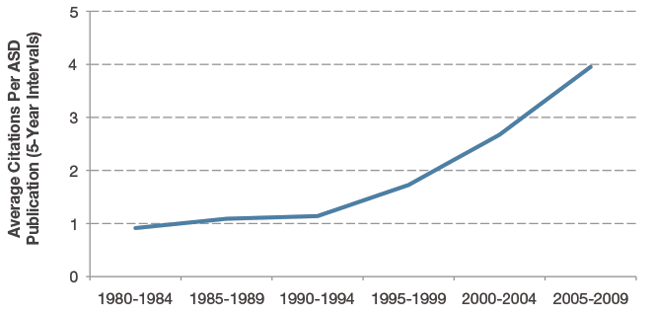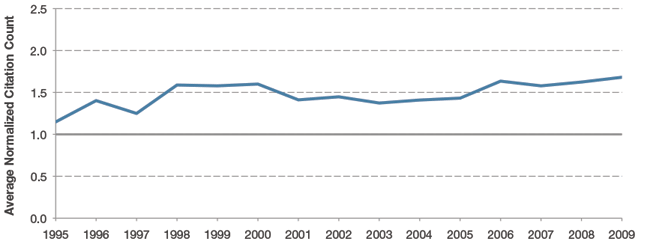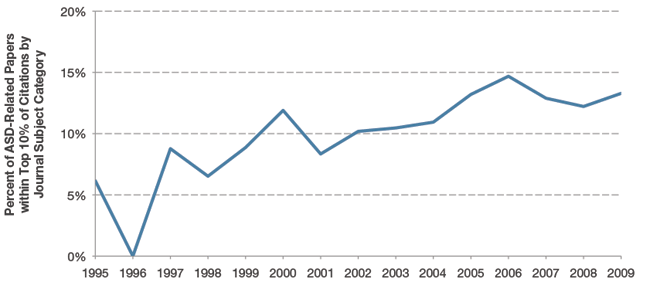Publications Analysis
Autism Spectrum Disorder Research
The Global Landscape of Autism Research
2012
While the annual numbers of ASD-related publications have grown since 1980, the quality of this research and the maturity of the field remain open questions. The following sections try to address these questions through a variety of measures.
What is the impact of autism research publications?
The "quality" of a research publication is a qualitative assessment that depends on underlying assumptions and values. This analysis focuses instead on several quantitative measures that can provide a more objective assessment of the published research.
The principal bibliometric measure of the impact of a publication within the research arena is the number of times it is cited by other, subsequent publications. When researchers cite published papers resulting from prior research, they are formally crediting the influence of that research on their own work. High citation rates, particularly within a short time after publication, can indicate that an article has a greater impact and influence on subsequent research than articles with lower citation rates.
For the purpose of this study, citations are counted for a period of two years from date of publication. This restriction provides an equitable basis of comparison for all publications from 1980 through 2009, since all have at least two years of subsequent history in which to count citations. Since publishing activity, and thus rate of citation, varies between disciplines and over time, observed citation counts for individual publications can be compared or normalized to the average for related fields, represented here by selected related Journal Subject Categories, and the year in which each paper was published. Both raw and normalized citation counts are used to determine the research impact of ASD-related publications. "Self-citations," citations from subsequent publications of the author(s) of the original work, are excluded from these measures.
Figure 12 shows that the 2-year citation rate for ASD publications remained fairly flat at approximately one citation per publication from 1980 to 1994, increasing in subsequent years to nearly four citations per publication in 2009. The increase in average citation counts over time may reflect increasing awareness of ASD in the research community and growth of the autism research field. As more research is published in the autism field, more autism publications are cited.
Autism Research Citation Rate from 1980 to 2009

Figure 12 . Autism Research Citation Rate from 1980 to 2009. The average 2-year citation counts per publication are plotted in 5-year intervals. With the assumption that citation rate can be used as a proxy measure of publication impact, these data suggest that the impact of autism research began to increase after 1994.
Another way of assessing publication output is to compare autism publication citation counts to the citation rate of related research fields. Focusing on publications from 1995 to 2009, Figure 13 shows the 2-year average citation counts of autism publications normalized to those in the Journal Subject Category comparison group ("Average Normalized Citation Count") published in the same year. A value of 1.0 would indicate that autism citation rates are the same as the comparison group. The normalized citation counts are consistently greater than 1.0 for autism research, peaking at 1.7 in 2009, which indicates that since 1995 autism research has been more highly cited than comparable research fields.
Impact of Autism Publications Compared to Average Citation Rates in Related Publications, 1995 to 2009

Figure 13. Impact of Autism Publications Compared to Average Citation Rates in Related Publications, 1995 to 2009. Annual average normalized citation counts are plotted from 1995 to 2009. Citation counts from each ASD publication are divided by the citation rate among all publications of the same Journal Subject Category in Web of Science® in the given year. The average values for ASD publications are consistently higher than 1.0 in each year, indicating a higher citation rate for autism research than the rate in related Journal Subject Categories. This can be interpreted as an indication of the relative high impact of autism research.
A subset of autism publications is among the most highly-cited research articles within the Journal Subject Category publication set. The proportion of ASD publications that are among this group is another measure of the influence and maturity of the autism research field. Figure 14 indicates the proportion of autism publications that are among the top 10% of citation counts within the Journal Subject Category for each year from 1995 to 2009. While only around 5% of autism research publications were among the most-frequently cited in the mid-nineties, this level has remained consistently between 12% and 15% since 2005. Both that autism publications are well-represented among the most-cited research and that this presence has increased substantially since the 1990s serve as strong indicators of the growing influence of the autism research field and provide evidence that autism research findings are reaching a larger community of researchers.
Proportion of Highly Cited Autism Publications from 1995 to 2009

Figure 14. Proportion of Highly Cited Autism Publications from 1995 to 2009. This graph shows the annual percentage of autism research publications with 2-year citation counts among the top 10% of related Journal Subject Category publications. The proportion of autism publications that reached this high level of citations increased between 1995 and 2009, indicating the growing influence of autism research.
How is the field of autism research maturing?
Along with the recent remarkable increase in the volume of autism publications produced each year, average citation counts are increasing and more autism articles are among the most highly-cited within their respective fields – all suggesting that the autism field has matured appreciably in the last decade. As a research field matures, one would expect the impact of its publications to increase and for its research findings to be cited by more researchers. Another measure of maturity, especially within biomedical research, is the relative extent of basic science versus translational science outputs.
In Chapter One, the basic Biology area was observed to be the largest area of research publications in autism research, which may suggest that autism is still a relatively young research field – a conclusion that is also supported by observation of the publication pattern for the field, which shows few publications prior to 1990, some growth in the 1990s, and a steep rise in growth from 2000 on (Figure 7). It is possible that in future years, there may be growth in or even a shift towards more translational types of research – such as diagnosis, treatments, interventions, and evidence-based services and supports – building on results yielded by more basic areas of study.
Another notable trend demonstrated in the two Spotlight sections on Risk Factor research and Treatments and Interventions research is that broad scientific innovations are being taken up quickly by the autism research field, notably in the areas of Genetic Risk Factors and Epigenetics, as well as Technology-Based Interventions and Supports. Rapidly changing and emerging fields such as genomics, epigenetics, communication technologies, and robotics are expanding opportunities to develop innovative approaches in autism research.
The likely drivers of the growing maturity of the autism field are enhanced public awareness of ASD, the uptake of research techniques and innovations from the broader scientific community, and increased research funding. Several governmental funding bodies, non-profit organizations, and private research foundations worldwide are leading the call for more research and are infusing significant investments into the field. The next chapter provides an analysis of funding acknowledgments from the 2010 autism publications to determine which organizations are funding autism research around the globe.
Main findings from analysis of impact and maturity of the autism research field:
- Current autism research has a higher impact than earlier publications.
- Work in autism is generally more highly cited than comparable research fields.
- The proportion of very highly cited articles with an autism research focus has increased since 1995.
- Publication volume, impact, and thematic trends suggest that autism is a young but rapidly growing and evolving research field encompassing several emerging subfields and influenced by advances in knowledge and technology from other scientific disciplines.




